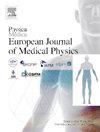ActiveNaf: A novel NeRF-based approach for low-dose CT image reconstruction through active learning
IF 3.3
3区 医学
Q1 RADIOLOGY, NUCLEAR MEDICINE & MEDICAL IMAGING
Physica Medica-European Journal of Medical Physics
Pub Date : 2025-05-22
DOI:10.1016/j.ejmp.2025.104997
引用次数: 0
Abstract
Background:
CT imaging provides essential information about internal anatomy; however, conventional CT imaging delivers radiation doses that can become problematic for patients requiring repeated imaging, highlighting the need for dose-reduction techniques. This study aims to reduce radiation doses without compromising image quality. We propose an approach that combines Neural Attenuation Fields (NAF) with an active learning strategy to better optimize CT reconstructions given a limited number of X-ray projections.
Method:
Our method uses a secondary neural network to predict the Peak Signal-to-Noise Ratio (PSNR) of 2D projections generated by NAF from a range of angles in the operational range of the CT scanner. This prediction serves as a guide for the active learning process in choosing the most informative projections. In contrast to conventional techniques that acquire all X-ray projections in a single session, our technique iteratively acquires projections. The iterative process improves reconstruction quality, reduces the number of required projections, and decreases patient radiation exposure.
Results:
We tested our methodology on spinal imaging using a limited subset of the VerSe 2020 dataset. We compare image quality metrics (PSNR3D, SSIM3D, and PSNR2D) to the baseline method and find significant improvements. Our method achieves the same quality with 36 projections as the baseline method achieves with 60.
Conclusions:
Our findings demonstrate that our approach achieves high-quality 3D CT reconstructions from sparse data, producing clearer and more detailed images of anatomical structures. This work lays the groundwork for advanced imaging techniques, paving the way for safer and more efficient medical imaging procedures.
ActiveNaf:一种基于nerf的基于主动学习的低剂量CT图像重建方法
背景:CT成像提供了内部解剖的基本信息;然而,传统的CT成像提供的辐射剂量对于需要反复成像的患者来说可能会成为问题,这突出了对剂量降低技术的需求。这项研究的目的是在不影响图像质量的情况下减少辐射剂量。我们提出了一种将神经衰减场(NAF)与主动学习策略相结合的方法,以更好地优化给定有限数量的x射线投影的CT重建。方法:利用二次神经网络预测NAF在CT扫描仪工作范围内不同角度产生的二维投影的峰值信噪比(PSNR)。这种预测可以作为主动学习过程中选择信息量最大的预测的指南。与在一次会话中获得所有x射线投影的传统技术相比,我们的技术迭代地获得投影。迭代过程提高了重建质量,减少了所需投影的数量,并减少了患者的辐射暴露。结果:我们使用VerSe 2020数据集的有限子集测试了我们的脊柱成像方法。我们将图像质量指标(PSNR3D, SSIM3D和PSNR2D)与基线方法进行比较,并发现显着改进。我们的方法用36个投影实现了与基线方法60个相同的质量。结论:我们的研究结果表明,我们的方法可以从稀疏的数据中获得高质量的3D CT重建,产生更清晰、更详细的解剖结构图像。这项工作为先进的成像技术奠定了基础,为更安全、更有效的医学成像程序铺平了道路。
本文章由计算机程序翻译,如有差异,请以英文原文为准。
求助全文
约1分钟内获得全文
求助全文
来源期刊
CiteScore
6.80
自引率
14.70%
发文量
493
审稿时长
78 days
期刊介绍:
Physica Medica, European Journal of Medical Physics, publishing with Elsevier from 2007, provides an international forum for research and reviews on the following main topics:
Medical Imaging
Radiation Therapy
Radiation Protection
Measuring Systems and Signal Processing
Education and training in Medical Physics
Professional issues in Medical Physics.

 求助内容:
求助内容: 应助结果提醒方式:
应助结果提醒方式:


